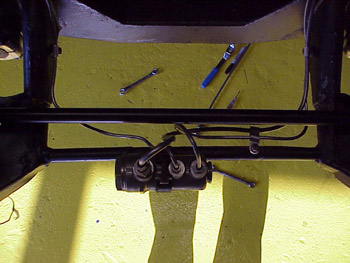A mysterious part found on 250 Series Ferraris is a brake valve that is often mounted below the radiator and is plumbed into the front brake system. In a discussion about brakes on the Vintage Ferrari Forum, one very good description and explanation came from Brian Brown who is a mechanic that works for Patrick Otis in Berkeley, CA. Parker Hall, of Kilimanjaro Designs, send me a personal e-mail with his description of the valve, and I decided to record these two notes permanently on my website, so we can all be enlightened. Thanks guys for the information!

The unit incorporated into the front brake circuit is not a valve, nor is it a safety braker. It is a proportioning cylinder. It is designed to increase the pressure to the front brakes.
It is very simple, has only two parts: a piston and a return spring. The way it works is that brake fluid pressure from the power brake booster is applied to the backside of the piston. This moves the piston forward. The front side of the piston has the same outer diameter as the rear, but the center of the front of the piston extends through a seal to the outside of the unit. so the effective area of the front side of the piston is the outer circle minus the inner circle (diameter of the part that sticks out from the unit).
Let's say that there is 100 psi coming from the brake booster and the back side of the piston is 1 square inch, now there is 100 pound of force pushing on the piston. Let's say that the front side of the piston is 1/2 a square inch (due to the center missing from the doughnut). 100 pounds of force divided by 1/2" creates 200PSI coming out of the unit.
The unit can cause the front brakes to stick on. If the piston sticks, then the front brakes will stay on. Also if the unit is improperly assembled, then the front brakes will stick on. There is a flat spot on the top of the piston, it must line up with the compensation ports on the housing, if it doesn't then then pressure in the unit cannot be released when the brakes are released.
The hardest thing about rebuilding the unit is finding seals that will work.
Otherwise it is about the simplest part on the whole car.
Later cars used a proportioning valve in the rear circuit to limit pressure to the rear brakes, rather than boosting pressure to the front.
Brian